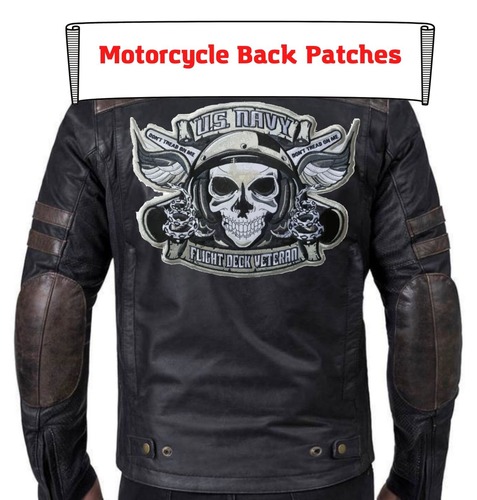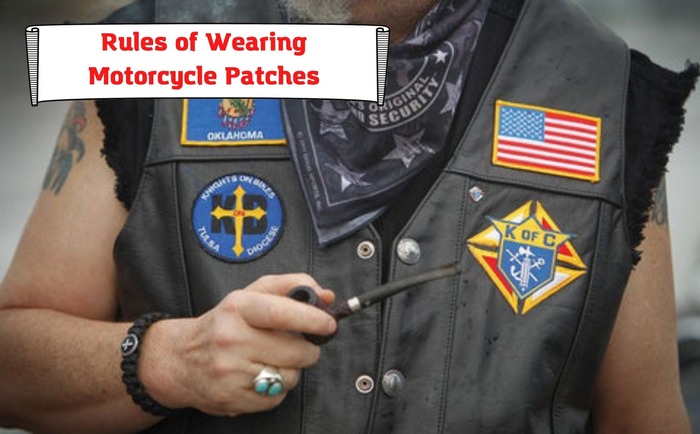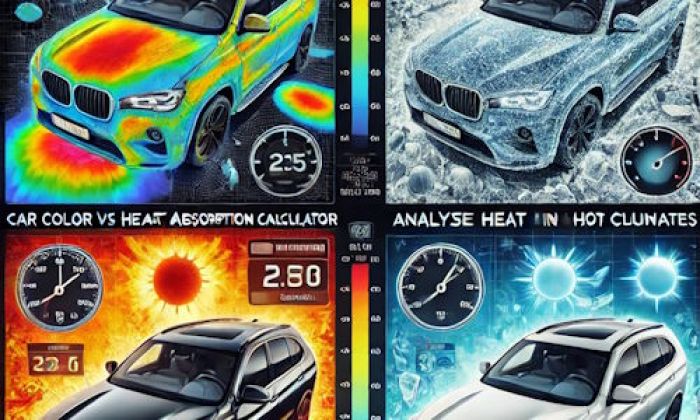
The colorful patches you see on a biker's vest are more than just a decoration. They hold vital information and meaning. It shows your identity and the type of club or group the biker belongs to.
Your motorcycle patch should proudly represent your riding or motorcycle club. Therefore, the size of your patch matters. You should pick a size and layout that conspicuously shows your club's identity, design, emblem, and colors. What's more, back patches should be larger and more noticeable. So, are there any rules you should follow before putting on a motorcycle back patch? Which large back patches can you wear?
You need to know and understand the etiquette and rules governing motorcycle patches if you intend to wear a back patch. Keep on reading to identify the large motorcycle patches you can wear.
What is a Motorcycle Patch?
Initially, motorcycle patches were seen as a symbol of freedom and defiance against authority. Over time they became insignia bikers wear to proclaim their connection to a motorcycle club or a riding group. They've become symbols of identity, markers of riding achievements, and an expression of loyalty to a particular motorcycle club, organization, or group. The patches contain the club's name, emblem, groups or club location, and the biker's accomplishments. The emblem represents the club's key symbol. Bikers wear patches on their vest, which holds great significance to their culture and traditions. Different motorcycle clubs use different styles and logos with hidden messages known to fellow riders.
Back Patches
These are large patches worn on the back. It's centrally placed. Bikers use back patches to illustrate their characters, individuality, or convey a message. A 12" is the standard size of a back patch. They have different meanings. For instance, a skull-cross bone design often shows that a biker escaped a close encounter with death experience. But it can mean a contrasting thing to a different motorcycle club.
A back patch makes your riding outfit quite stylish. Being the center stage for your patches, use the back patches to identify yourself and express your personality boldly to the world.
Types of Back Patches
One Piece or Single Back Patch
The one-piece back patch shows the biker is connected to a riding group/ club or motorcycle organization. The one-piece back patch often holds the group's or club's name, location, and/or the symbol of the motorcycle organization. The single back patch is an indication that the American Motorcycle Association (AMA) has approved the riding club/group.
Two-Piece Back Patch
The two-piece back patch suggests that the user is waiting for approval to join a motorcycle club. You need to be cautious of how you layout the two-piece back patch. It should not infringe or look like the patches of local clubs in your region.
Three-Piece Back Patch
The three-piece back patch shows that one is a member of a motorcycle club, be it a legal or outlaw. The patch comes in three, a top rocker, the club's symbol or emblem, and a bottom rocker. The top piece holds the name of the group/club. The middle piece carries the design of the club's logo or emblem. The last piece shows the locale of the club.
Biker Rockers
A biker places this patch either at the top or lower back. The biker rockers are reserved for bikers belonging to a leading club in their location. Dominant clubs often use biker rockers to declare their dominance.
Patch Layout
You probably have a leather vest or jacket if you love riding motorcycles. You don't put it on as protective gear but rather as a conversation starter by the embellishments on the jacket or the vest. The patches will let others know the motorcycle clubs, groups, or organizations you're connected to, the places you've ridden on, the races you've participated in, and the people you know. You can tell this if you wear the right patch layout.
Motorcycle patches come in different shapes, designs, and sizes. Wear a large back patch if you're a fully-fledged member of a motorcycle organization or club. Custom patches have no restrictions. You can put them on any part of the vest. But your need to consider acceptable designs, patch layout, and requirements.
Large Patches You Can Wear
If you plan on wearing a custom large patch, a flag, name, brand-based, activity, funny, or political statement patch, is the right route to take. You can wear this anytime and anywhere without risking a confrontation from motorcycle clubs or groups within your locale. But ensure you don't infringe on the colors or patches of the local clubs within your area.
There are a few motorcycle patches you need to avoid.
The 1% patch
The 1% patch should be avoided by all means. Members of outlaw motorcycle clubs wear the 1% patches. By wearing a 1% patch, you declare your affiliation to such clubs. Considering how the media portrays such clubs, you'd not want to be seen adorning a 1% patch. Putting on a 1% puts you on the law enforcement and the 1% clubs’ radar.
13 Patch
The patch has a distinctive meaning. If you put this patch, you openly declare that you are a drug dealer or narcotics user. #13 represents the letter 'M' and often stands for Marijuana or Methamphetamine in the biker world. In some other instances, if you put on the #13 patch, you communicate to others that you are your own judge.
The '13' patch can be traced back to Southern California. The patch initially stood for the first 13 outlaw motorcycle clubs. Any outlaw clubs that emerged top 13 were awarded the patch. Once awarded the club became part of the diamond club, an outlaw racing scene. When the 1% drift ensued, the #13 patch changed to a 1% patch.
An FTW patch
If you put on an FTW patch, you proclaim that you are an absolute rebel. But if you're an absolute rebel, why not.
Sons of Anarchy patch
Be ready to defend the patch if you choose to wear it while riding your motorcycle. Earning Sons of Anarchy patches takes years, thus may be considered disrespectful by members. Sons of Anarchy MC members may force you to remove or destroy the patch.
Hells Angels/ 81 Patches
The Hells Angels patches are an off-limit to non-members. Hells Angels protect their identity, name, and logo with earnest intent. You can try putting it on, but the members will definitely approach you if they notice the patch. The members will ask you to remove the patch, and if you don't comply the situation may turn serious within a second.
Rules of Wearing Motorcycle Patches

It is important to understand the rules on back patches. Riders closely protect their biking traditions and culture. Patch rules are an integral part of that culture.
The rules and etiquette differ from club to club. However, general rules and etiquette apply to scenarios you may face as you ride your motorcycle.
- Be cautious of how and where you put the patch. Motorcycle patches have special traditions and significance and must be put on in respect to these traditions. Some clubs strictly require their members to put patches on the sleeveless vests. So, if you decide to put your patches on a sleeveless vest, ensure you do it with consideration of such rules.
- Don't wear motorcycle patches that exclusively belong to a particular motorcycle club. Never put on a motorcycle club patch if you are not an approved member of the club. These patches hold a sentimental value to club members. You can opt for funny patches, flags patches, name patches, or political statement patches to avoid any nasty encounters as you ride your motorcycle. You can put these patches anywhere on your jacket or vest.
- If you decide to quit or lose your club's membership, you should relinquish your colors. You should never reuse those patches after you leave the club.
- Another members' colors are a no-go zone. Colors are seen as sacred elements in motorcycle clubs. It's not a wonder to see members vehemently defend their colors. Besides, colors stand for members' commitment.
- Don't borrow or wear another member's vest.
- Club frown upon commercialization of patches. Most bikers appreciate it if you earn your patch instead of buying it. Buying a club patch is seen as disrespecting the club's personality. It takes time, and effort to earn a club patch.
Familiarize yourself with the local clubs' patches before getting a customized motorcycle back patch. Go further and ask the local clubs for approval to put on the patch to avoid any future confrontations. It's not necessary but a way to show that you respect the local clubs.
Wrap Up
Before putting on a patch you need to understand patch rules and the different meanings of the symbols on your patch. You may violate patch rules of local clubs or groups if you're not cautious. Bikers treasure their culture. They hold their patches in high esteem. A violation of any patch rule can result in a confrontation.
About the authors
The CarAraC research team is composed of seasoned auto mechanics and automotive industry professionals, including individuals with advanced degrees and certifications in their field. Our team members boast prestigious credentials, reflecting their extensive knowledge and skills. These qualifications include: IMI: Institute of the Motor Industry, ASE-Certified Master Automobile Technicians; Coventry University, Graduate of MA in Automotive Journalism; Politecnico di Torino, Italy, MS Automotive Engineering; Ss. Cyril and Methodius University in Skopje, Mechanical University in Skopje; TOC Automotive College; DHA Suffa University, Department of Mechanical Engineering






Add comment